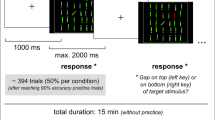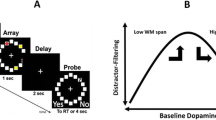Abstract
Rationale
The dopaminergic system has been implicated in visuospatial attention and inhibition, but the exact role has yet to be elucidated. Scarce literature suggests that attenuation of dopaminergic neurotransmission negatively affects attentional focusing and inhibition. To the best of our knowledge, this is the first study that evaluated the effect of dopaminergic antagonism on stopping performance.
Methods
Dopaminergic neurotransmission was attenuated in 28 healthy male participants by using 2 mg haloperidol. A repeated-measures placebo-controlled crossover design was implemented, and performance indices of attention and inhibition were assessed in the visual spatial cueing task (VSC) and stop signal task (SST). Additionally, the effect of haloperidol on motoric parameters was assessed. It was expected that haloperidol as contrasted to placebo would result in a reduction of the “validity effect,” the benefit of valid cueing as opposed to invalid cueing of a target in terms of reaction time. Furthermore, an increase in stop signal reaction time (SSRT) in the SST was expected.
Results and conclusion
Results partially confirmed the hypothesis. Haloperidol negatively affected inhibitory motor control in the SST as indexed by SSRT, but there were no indications that haloperidol affected bias or disengagement in the VSC task as indicated by a lack of an effect on RTs. Pertaining to secondary parameters, motor activity increased significantly under haloperidol. Haloperidol negatively affected reaction time variability and errors in both tasks, as well as omissions in the SST, indicating a decreased sustained attention, an increase in premature responses, and an increase in lapses of attention, respectively.



Similar content being viewed by others
References
Arnsten AFT (2004) Adrenergic targets for the treatment of cognitive deficits in schizophrenia. Psychopharmacology 174:25–31. doi:10.1007/s00213-003-1724-3
Arnsten AF, Mathew R, Ubriani R et al (1999) Alpha-1 noradrenergic receptor stimulation impairs prefrontal cortical cognitive function. Biol Psychiatry 45:26–31
Aron AR, Fletcher PC, Bullmore ET et al (2003) Stop-signal inhibition disrupted by damage to right inferior frontal gyrus in humans. Nat Neurosci 6:115–116. doi:10.1038/nn1003
Aron AR, Robbins TW, Poldrack RA (2014) Inhibition and the right inferior frontal cortex: one decade on. Trends Cogn Sci 18:177–185. doi:10.1016/j.tics.2013.12.003
Bari A, Robbins TW (2013) Noradrenergic versus dopaminergic modulation of impulsivity, attention and monitoring behaviour in rats performing the stop-signal task: possible relevance to ADHD. Psychopharmacology 230:89–111. doi:10.1007/s00213-013-3141-6
Bari A, Eagle DM, Mar AC et al (2009) Dissociable effects of noradrenaline, dopamine, and serotonin uptake blockade on stop task performance in rats. Psychopharmacology 205:273–283. doi:10.1007/s00213-009-1537-0
Bekker EM, Overtoom CC, Kenemans JL et al (2005) Stopping and changing in adults with ADHD. Psychol Med 35:807–816
Caligiuri MP, Lohr JB, Ruck RK (1998) Scaling of movement velocity: a measure of neuromotor retardation in individuals with psychopathology. Psychophysiology 35:431–437
Castellanos FX, Tannock R (2002) Neuroscience of attention-deficit/hyperactivity disorder: the search for endophenotypes. Nat Rev Neurosci 3:617–628. doi:10.1038/nrn896
Clark CR, Geffen GM, Geffen LB (1989) Catecholamines and the covert orientation of attention in humans. Neuropsychologia 27:131–139
Colzato LS, Jongkees BJ, Sellaro R et al (2014) Eating to stop: tyrosine supplementation enhances inhibitory control but not response execution. Neuropsychologia 62:398–402. doi:10.1016/j.neuropsychologia.2013.12.027
Corbetta M, Shulman GL (2002) Control of goal-directed and stimulus-driven attention in the brain. Nat Rev Neurosci 3:201–215. doi:10.1038/nrn755
Corbetta M, Patel G, Shulman GL (2008) The reorienting system of the human brain: from environment to theory of mind. Neuron 58:306–324. doi:10.1016/j.neuron.2008.04.017
Coull JT, Nobre AC, Frith CD (2001) The noradrenergic alpha2 agonist clonidine modulates behavioural and neuroanatomical correlates of human attentional orienting and alerting. Cereb Cortex N Y N 11:73–841991
de Jong R, Coles MG, Logan GD, Gratton G (1990) In search of the point of no return: the control of response processes. J Exp Psychol Hum Percept Perform 16:164–182. doi:10.1037/0096-1523.16.1.164
De Jong R, Coles MG, Logan GD (1995) Strategies and mechanisms in nonselective and selective inhibitory motor control. J Exp Psychol Hum Percept Perform 21:498–511
Eagle DM, Wong JCK, Allan ME et al (2011) Contrasting roles for dopamine D1 and D2 receptor subtypes in the dorsomedial striatum but not the nucleus accumbens core during behavioral inhibition in the stop-signal task in rats. J Neurosci 31:7349–7356. doi:10.1523/JNEUROSCI.6182-10.2011
Ghahremani DG, Lee B, Robertson CL et al (2012) Striatal dopamine D2/D3 receptors mediate response inhibition and related activity in frontostriatal neural circuitry in humans. J Neurosci 32:7316–7324. doi:10.1523/JNEUROSCI.4284-11.2012
Gurvich CT, Rossell SL (2014) Genetic variations in dopamine and inhibitory control: lack of influence on action restraint. Behav Brain Res 267:12–16. doi:10.1016/j.bbr.2014.03.015
Janno S, Holi MM, Tuisku K, Wahlbeck K (2008) Neuroleptic-induced movement disorders in a naturalistic schizophrenia population: diagnostic value of actometric movement patterns. BMC Neurol 8:10. doi:10.1186/1471-2377-8-10
Kapur S, Zipursky R, Jones C et al (2000) Relationship between dopamine D(2) occupancy, clinical response, and side effects: a double-blind PET study of first-episode schizophrenia. Am J Psychiatry 157:514–520
Kenemans JL (2015) Specific proactive and generic reactive inhibition. Neurosci Biobehav Rev 56:115–126. doi:10.1016/j.neubiorev.2015.06.011
Kenemans JL, Kähkönen S (2011) How human electrophysiology informs psychopharmacology: from bottom-up driven processing to top-down control. Neuropsychopharmacol Off Publ Am Coll Neuropsychopharmacol 36:26–51. doi:10.1038/npp.2010.157
Kenemans JL, Bekker EM, Lijffijt M et al (2005) Attention deficit and impulsivity: selecting, shifting, and stopping. Int J Psychophysiol 58:59–70. doi:10.1016/j.ijpsycho.2005.03.009
Kroeze WK, Hufeisen SJ, Popadak BA et al (2003) H1-histamine receptor affinity predicts short-term weight gain for typical and atypical antipsychotic drugs. Neuropsychopharmacol Off Publ Am Coll Neuropsychopharmacol 28:519–526. doi:10.1038/sj.npp.1300027
Kumari V, Corr PJ, Mulligan OF et al (1997) Effects of acute administration of d-amphetamine and haloperidol on procedural learning in man. Psychopharmacology 129:271–276
Kumari V, Cotter PA, Mulligan OF et al (1999) Effects of d-amphetamine and haloperidol on latent inhibition in healthy male volunteers. J Psychopharmacol Oxf Engl 13:398–405
Lansbergen MM, Böcker KBE, Bekker EM, Kenemans JL (2007) Neural correlates of stopping and self-reported impulsivity. Clin Neurophysiol Off J Int Fed Clin Neurophysiol 118:2089–2103. doi:10.1016/j.clinph.2007.06.011
Leysen JE, Janssen PM, Gommeren W et al (1992) In vitro and in vivo receptor binding and effects on monoamine turnover in rat brain regions of the novel antipsychotics risperidone and ocaperidone. Mol Pharmacol 41:494–508
Lijffijt M, Kenemans JL, ter Wal A et al (2006) Dose-related effect of methylphenidate on stopping and changing in children with attention-deficit/hyperactivity disorder. Eur Psychiatry J Assoc Eur Psychiatr 21:544–547. doi:10.1016/j.eurpsy.2005.04.003
Logan GD, Cowan WB, Davis KA (1984) On the ability to inhibit simple and choice reaction time responses: a model and a method. J Exp Psychol Hum Percept Perform 10:276–291
Logemann HNA, Böcker KBE, Deschamps PKH et al (2013) The effect of noradrenergic attenuation by clonidine on inhibition in the stop signal task. Pharmacol Biochem Behav 110:104–111. doi:10.1016/j.pbb.2013.06.007
Logemann HNA, Böcker KBE, Deschamps PKH et al (2014) The effect of attenuating noradrenergic neurotransmission by clonidine on brain activity measures of visuospatial attention. Hum Psychopharmacol Clin Exp 29:46–54. doi:10.1002/hup.2367
Mangun GR, Hillyard SA (1991) Modulations of sensory-evoked brain potentials indicate changes in perceptual processing during visual-spatial priming. J Exp Psychol Hum Percept Perform 17:1057–1074. doi:10.1037/0096-1523.17.4.1057
Meinke A, Thiel CM, Fink GR (2006) Effects of nicotine on visuo-spatial selective attention as indexed by event-related potentials. Neuroscience 141:201–212. doi:10.1016/j.neuroscience.2006.03.072
Nandam LS, Hester R, Wagner J et al (2011) Methylphenidate but not atomoxetine or citalopram modulates inhibitory control and response time variability. Biol Psychiatry 69:902–904. doi:10.1016/j.biopsych.2010.11.014
Nyberg S, Nordström AL, Halldin C, Farde L (1995) Positron emission tomography studies on D2 dopamine receptor occupancy and plasma antipsychotic drug levels in man. Int Clin Psychopharmacol 10(Suppl 3):81–85
Overtoom CCE, Bekker EM, van der Molen MW et al (2009) Methylphenidate restores link between stop-signal sensory impact and successful stopping in adults with attention-deficit/hyperactivity disorder. Biol Psychiatry 65:614–619. doi:10.1016/j.biopsych.2008.10.048
Posner MI, Snyder CR, Davidson BJ (1980) Attention and the detection of signals. J Exp Psychol 109:160–174
Potter AS, Bucci DJ, Newhouse PA (2012) Manipulation of nicotinic acetylcholine receptors differentially affects behavioral inhibition in human subjects with and without disordered baseline impulsivity. Psychopharmacology 220:331–340. doi:10.1007/s00213-011-2476-0
Ramdani C, Carbonnell L, Vidal F, Béranger C, Dagher A, Hasbroucq T (2015) Dopamine precursors depletion impairs impulse control in healthy volunteers. Psychopharmacology 232(2):477–487
Richelson E, Nelson A (1984) Antagonism by neuroleptics of neurotransmitter receptors of normal human brain in vitro. Eur J Pharmacol 103:197–204
Saeedi H, Remington G, Christensen BK (2006) Impact of haloperidol, a dopamine D2 antagonist, on cognition and mood. Schizophr Res 85:222–231. doi:10.1016/j.schres.2006.03.033
Schmajuk M, Liotti M, Busse L, Woldorff MG (2006) Electrophysiological activity underlying inhibitory control processes in normal adults. Neuropsychologia 44:384–395. doi:10.1016/j.neuropsychologia.2005.06.005
Schotte A, Janssen PF, Gommeren W et al (1996) Risperidone compared with new and reference antipsychotic drugs: in vitro and in vivo receptor binding. Psychopharmacology 124:57–73
Simon JR, Wolf JD (1963) Choice reaction time as a function of angular stimulus-response correspondence and age. Ergonomics 6(1):99–105
Tannock R, Schachar RJ, Carr RP, Chajczyk D, Logan GD (1989) Effects of methylphenidate on inhibitory control in hyperactive children. J Abnorm Child Psychol 17(5):473–491
Thiel CM, Fink GR (2008) Effects of the cholinergic agonist nicotine on reorienting of visual spatial attention and top-down attentional control. Neuroscience 152:381–390. doi:10.1016/j.neuroscience.2007.10.061
Thiel CM, Zilles K, Fink GR (2005) Nicotine modulates reorienting of visuospatial attention and neural activity in human parietal cortex. Neuropsychopharmacol Off Publ Am Coll Neuropsychopharmacol 30:810–820. doi:10.1038/sj.npp.1300633
van der Lubbe RHJ, Neggers SFW, Verleger R, Kenemans JL (2006) Spatiotemporal overlap between brain activation related to saccade preparation and attentional orienting. Brain Res 1072:133–152. doi:10.1016/j.brainres.2005.11.087
Verbruggen F, Chambers CD, Logan GD (2013) Fictitious inhibitory differences: how skewness and slowing distort the estimation of stopping latencies. Psychol Sci 24:352–362. doi:10.1177/0956797612457390
Volkow ND, Wang G-J, Kollins SH et al (2009) Evaluating dopamine reward pathway in ADHD: clinical implications. JAMA 302:1084–1091. doi:10.1001/jama.2009.1308
Vossel S, Thiel CM, Fink GR (2008) Behavioral and neural effects of nicotine on visuospatial attentional reorienting in non-smoking subjects. Neuropsychopharmacol Off Publ Am Coll Neuropsychopharmacol 33:731–738. doi:10.1038/sj.npp.1301469
Wald, F.D.M. (1984) De verkorte POMS. Master’s thesis.
Wald FDM, Mellenbergh GJ (1990) Instrumenteel onderzoek. Ned Tijdschr Voor Psychol 45:86–90
Witte EA, Davidson MC, Marrocco RT (1997) Effects of altering brain cholinergic activity on covert orienting of attention: comparison of monkey and human performance. Psychopharmacology 132:324–334
Zetterström T, Sharp T, Collin AK, Ungerstedt U (1988) In vivo measurement of extracellular dopamine and DOPAC in rat striatum after various dopamine-releasing drugs; implications for the origin of extracellular DOPAC. Eur J Pharmacol 148:327–334
Zirnheld PJ, Carroll CA, Kieffaber PD et al (2004) Haloperidol impairs learning and error-related negativity in humans. J Cogn Neurosci 16:1098–1112. doi:10.1162/0898929041502779
Author information
Authors and Affiliations
Corresponding author
Ethics declarations
Conflict of interest
There is no conflict of interest to disclose.
Rights and permissions
About this article
Cite this article
Logemann, H.A., Böcker, K.B., Deschamps, P.K. et al. Haloperidol 2 mg impairs inhibition but not visuospatial attention. Psychopharmacology 234, 235–244 (2017). https://doi.org/10.1007/s00213-016-4454-z
Received:
Accepted:
Published:
Issue Date:
DOI: https://doi.org/10.1007/s00213-016-4454-z




